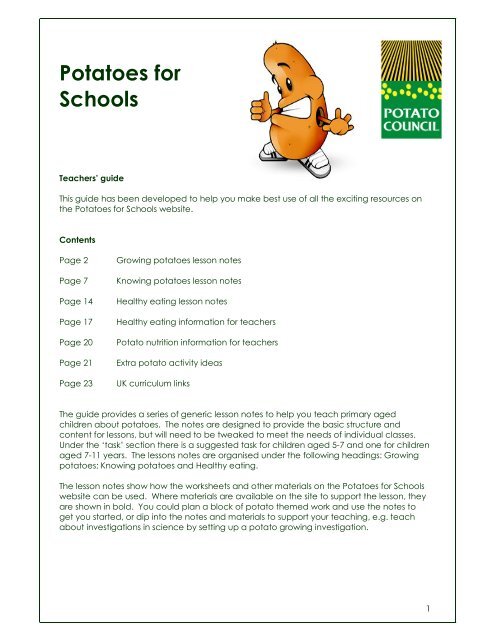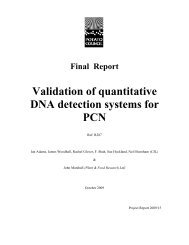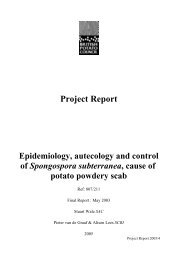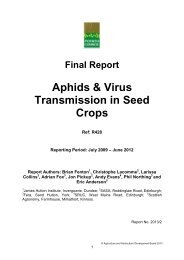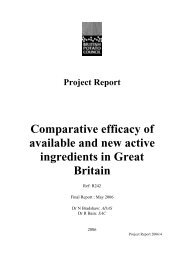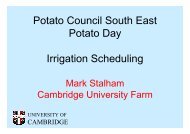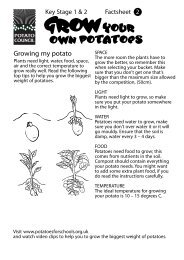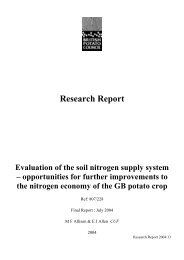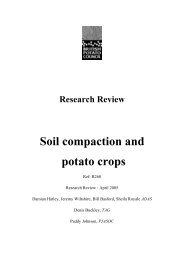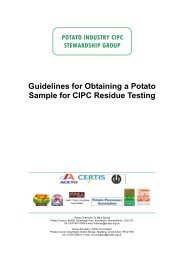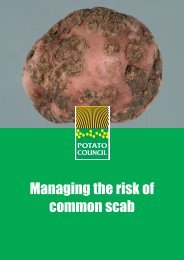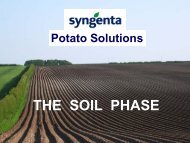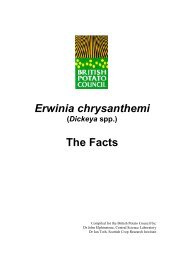Potatoes for Schools - Grow Your Own Potatoes - Potato Council
Potatoes for Schools - Grow Your Own Potatoes - Potato Council
Potatoes for Schools - Grow Your Own Potatoes - Potato Council
You also want an ePaper? Increase the reach of your titles
YUMPU automatically turns print PDFs into web optimized ePapers that Google loves.
<strong><strong>Potato</strong>es</strong> <strong>for</strong><strong>Schools</strong>Teachers’ guideThis guide has been developed to help you make best use of all the exciting resources onthe <strong><strong>Potato</strong>es</strong> <strong>for</strong> <strong>Schools</strong> website.ContentsPage 2Page 7Page 14Page 17Page 20Page 21Page 23<strong>Grow</strong>ing potatoes lesson notesKnowing potatoes lesson notesHealthy eating lesson notesHealthy eating in<strong>for</strong>mation <strong>for</strong> teachers<strong>Potato</strong> nutrition in<strong>for</strong>mation <strong>for</strong> teachersExtra potato activity ideasUK curriculum linksThe guide provides a series of generic lesson notes to help you teach primary agedchildren about potatoes. The notes are designed to provide the basic structure andcontent <strong>for</strong> lessons, but will need to be tweaked to meet the needs of individual classes.Under the ‘task’ section there is a suggested task <strong>for</strong> children aged 5-7 and one <strong>for</strong> childrenaged 7-11 years. The lessons notes are organised under the following headings: <strong>Grow</strong>ingpotatoes; Knowing potatoes and Healthy eating.The lesson notes show how the worksheets and other materials on the <strong><strong>Potato</strong>es</strong> <strong>for</strong> <strong>Schools</strong>website can be used. Where materials are available on the site to support the lesson, theyare shown in bold. You could plan a block of potato themed work and use the notes toget you started, or dip into the notes and materials to support your teaching, e.g. teachabout investigations in science by setting up a potato growing investigation.1
<strong>Grow</strong>ing potatoesLesson 1Children will:• learn what a potato plant looks like and how potatoes grow.IntroductionExplain to the children that they will be learning about potatoes. Ask them to tell you whatthey know about potatoes. Prompt them with the following questions, collect children’sanswers without confirming any ideas at this time:• What do potatoes look like?• Where do potatoes come from?• What do you think a potato plant looks like?• Is a potato plant alive?• What part of a plant does a potato come from?• How are potatoes cooked?• How long do you think they take to grow?• What time of the year are they planted and harvested?Ensure the children understand that potatoes come from a plant and that they are calledtubers – a part of the plant connected to the root. Explain that potatoes grown under theground. Use the <strong>Grow</strong>ing potatoes PowerPoint to show the children what a potato plantlooks like and how potatoes grow. You may wish to enlarge a copy of the <strong>Potato</strong> plantworksheet <strong>for</strong> discussion or display. With older children, discuss the functions of the differentparts of the plant, e.g. roots anchor the plant, leaves help the plant produce food –photosynthesis.Task5-7I love my potato worksheet – label and colour the picture.Discuss the different plant parts with the children. On a board or flip chart, make a list ofthe different plant parts <strong>for</strong> the children to use when they fill in their own sheet, or you couldleave the relevant PowerPoint slide showing.7-11Get the children to carry out some potato research in small groups. Each group shouldcreate a potato fact sheet. This should include - what a potato plant looks like, a labelledsketch, the function of different plant parts, the life processes of the plant, e.g. growth,nutrition, movement, reproduction. It could also include in<strong>for</strong>mation about: growingpotatoes, what a potato needs in order to grow well; where in the UK potatoes are grown;types of potatoes grown in the UK; how to store potatoes; how long they take to grow.SummaryTalk to the children about their tasks and what they have learnt. Ask some of the childrento share their work.Why not…• Set up a display of different types of potatoes;• Ask children to record how many times they eat potatoes over a week;• Let the children play The potato year activity. This can be found in the ‘Play it’ areaof the children section on the website.2
<strong>Grow</strong>ing potatoesLesson 2This session can be used to help your entry to the <strong>Grow</strong> <strong>Your</strong> <strong>Own</strong><strong><strong>Potato</strong>es</strong> competition. Go to: http://www.potatoes<strong>for</strong>schools.org.ukChildren will:• learn how to grow their own potato.You will need to prepare the seed potato a few weeks in advance in order to do theplanting in this session. See in<strong>for</strong>mation on the Planting my potato. This sheet can be foundin the ‘<strong>Grow</strong> it’ area of the children section on the website.Children can work in groups of 4-5 and will need a set of these items per group:• Seed potato/es – use those provided by the <strong>Potato</strong> <strong>Council</strong> if you are entering the<strong>Grow</strong> <strong>Your</strong> <strong>Own</strong> <strong><strong>Potato</strong>es</strong> competition;• Buckets, or growing beds in your school grounds - use the grow bag provided by the<strong>Potato</strong> <strong>Council</strong> if you wish are entering the competition.• Soil/compost;• Trowels;• Plastic gloves: optional. Hands must be washed thoroughly after handling potatoesif gloves are not used;• Watering can: optional.If you register <strong>for</strong> the <strong>Grow</strong> <strong>Your</strong> <strong>Own</strong> <strong><strong>Potato</strong>es</strong> competition, you could be in with a chanceof claiming a grow your own potato kit which includes some of these items.IntroductionExplain to the children that they will be planting a potato. Question the children:• What equipment will we need in order to grow a potato? Make a list.• Can you explain exactly what you think we will need to do, step by step?Look at the <strong>Grow</strong>ing my potato factsheet and show the children the video clips of potatoesbeing planted. Both these can be found in the ‘<strong>Grow</strong> it’ area of the children section on thewebsite. Discuss what is happening and ask the children about how they could do thiswhen they plant their potatoes. Summerise what the potatoes need to grow. Establish thatthe potato – tuber, is a seed.TaskBe<strong>for</strong>e you begin, establish who will be doing what part of the planting.Split the children into groups of 4 or 5. Talk them through how they will use the equipmentto plant their potatoes. This will vary depending on whether you have a school garden inwhich to grow them, or whether you will be growing them in buckets. Remember to usethe grow bags provided if you wish to enter the <strong>Grow</strong> <strong>Your</strong> <strong>Own</strong> <strong><strong>Potato</strong>es</strong> competition.Caution: if you are using buckets or grow bags, these will be quite heavy when filled withsoil. Put them where you want them to be be<strong>for</strong>e you fill them. Allow the children to planttheir potatoes.5-7How my potato grows worksheet – involves sketching how the potato looks at 3 weekintervals. Talk through the worksheet with the children and explain that they will fill it inevery three weeks. Talk about what they will be drawing over the coming weeks. You maylike them to do a sketch of the planted potato or you may wish to wait <strong>for</strong> the first 3 weekinterval be<strong>for</strong>e you begin. With young or less able children, you could enlarge theworksheet and fill it in as a class.3
7-11Create a story board/diary to record how the potato grows at regular intervals.SummaryTalk to the children about what they will have to do to care <strong>for</strong> their potatoes. Get them todecide how they will ensure their potatoes are cared <strong>for</strong>, e.g. a watering rota.Why not…• Get the children to measure the height of their potatoes at regular intervals over thecoming weeks and create a graph.• Get the children to write a set of instructions to tell someone how to grow a potato.• <strong>Grow</strong> a different type of plant which provides food, e.g. bean, cress. Compare howthis plant and your potato plant grow. Use the <strong><strong>Potato</strong>es</strong> and other plants worksheetto compare to two plants.• Find out about other root vegetables. You could use the Discover potatoesworksheet.• Look at the potato cam in the children’s area to see other potatoes growing. Go to:http://www.potatoes<strong>for</strong>schools.org.uk/home• You could grow different varieties of potatoes. The <strong>Potato</strong> <strong>Council</strong> have providedtwo different varieties in their growing kit <strong>for</strong> this purpose. Use the Spot the differenceworksheets to investigate the difference between the varieties.4
<strong>Grow</strong>ing potatoesLesson 3Children will:• learn what potatoes need in order to grow well.Children can work in groups of 4-5 and will need a set of these items per group.• Seed potato/es• Buckets (unless you have growing beds in your school grounds)• Soil/compost• Trowels• Plastic gloves: optional. Hands must be washed thoroughly after handling potatoesif gloves are not used.• Watering can: optional• Additional items to set up the different conditions <strong>for</strong> the potatoes.This investigation can be set up separately or in conjunction with the previous session. If it isdone as part of the previous session the ‘control’ potato/es can be the one/s used <strong>for</strong> the<strong>Grow</strong> <strong>Your</strong> <strong>Own</strong> <strong>Potato</strong> competition.IntroductionTalk to the children about what they think is needed to make a potato grow well (light,water). Ask the children how they know this, and how they could confirm what they think.Establish that they could remove or change one of the conditions they think the potatoneeds and see if it makes any difference. Discuss the condition changes you could try, e.g.temperature, water, light, soil. You could look at the <strong>Grow</strong> potatoes worksheet <strong>for</strong> ideas.With older children, these can be referred to as variables or factors. Explain that in order tosee whether making these changes makes any difference, you must grow a potato in theusual way as well, so you can compare them. The potato grown in the usual way is calledthe control. The other potato must also been grown in the same way with just onecondition/variable/factor changed so you can see if that is what really makes adifference. With younger children you could simply plant a control and one variable/factor, as a class. With older children, each group can do a different variable/factor butmake sure one group plants a control or you set up a class control.TaskWorking in small groups, get the children to plant their potatoes. Talk this through togetherfirst to emphasis the importance of ensuring that only the variable/factor is changed andthe rest is the same, so it is a fair test. Discuss the idea of a ‘fair test’ with the children toensure they understand. If you are just planting two potatoes with younger children, do thiswith all the children, getting some of them to help.5-7You could set up a class record or children could keep their own records.7-11Use the <strong>Grow</strong> potatoes 1a worksheet. The children can observe their own potato andthose of other class mates so they have four plants to compare. Alternatively, they coulduse the <strong>Potato</strong> investigations worksheets to compare the control and a potato growndifferently.5
SummaryRe-cap on what you have done, question the children:• What are we trying to find out?• What have we done?• What do you think will happen?• How have you made sure it is a fair test?Discuss how you will be recording the investigation including how often observations bemade.Why not…• <strong>Grow</strong> different types of potatoes and investigate which type grow faster and howthey differ in appearance? Use the two varieties provided by the <strong>Potato</strong> <strong>Council</strong>.You could use the Are they the same? worksheet to help record your findings.• Let the children have a go at the ‘<strong>Grow</strong> it’ activity in the ‘Play it’ section of thewebsite.6
Knowing potatoesLesson 4Children will:• learn that there are different types of potatoes and that theycan be prepared and cooked in different ways, some potatoesare more suitable <strong>for</strong> certain dishes than others due to theircharacteristics.For this session you will need 4-5 different types of potatoes. Ideally ones that look differentfrom each other and are <strong>for</strong> different purposes, e.g. baking, mashing. Check the Types ofpotato worksheet <strong>for</strong> ideas.IntroductionExplain to the children that there are lots of different types of potatoes. Show the childrena selection of different potatoes and ask them to describe the differences and similarities.You could pass the potatoes around so the children can handle them. Make sure thechildren wash their hands after handling the potatoes.Explain that different potatoes are good <strong>for</strong> making different dishes. Using the Knowingpotatoes PowerPoint, explain that some potatoes are ‘floury’ and some potatoes are‘waxy’. Floury potatoes crumble when they are cooked. These are good <strong>for</strong> making disheslike mashed potato. ‘Waxy’ potatoes keep their shape well when they are cooked. Waxypotatoes are good <strong>for</strong> dishes like potato salad because they hold their shape.Ask the children to tell you about meals they have eaten which include potatoes. Make alist of different dishes and meals which include potatoes. You might want to look at anenlarged copy of the Types of potatoes worksheet and discuss which types of potatoesmight have been used in the dishes they have tried. Discuss the ways potatoes can becooked, e.g. boiled, roasted, mashed.Task5-7Get the children to draw of some of their favourite potato dishes and meals.7-11Provide the children with Types of potato worksheet (4 and 4a). The in<strong>for</strong>mation onworksheet 4 will help the children complete worksheet 4a. Question the children on sheet 4to check they understand the key which indicates how waxy or floury the potatoes are.Get the children to design a poster to show people the different dishes and/or meals theycan create with potatoes.SummaryConsolidate children’s learning by asking them the following questions:• What is a waxy potato?• What is a floury potato?• What could you make from each type of potato?• Can you name two varieties of potato?• What is your favourite potato dish or meal?7
Why not…• Challenge the children to try and find out how many different types of potatoesthere are. What is the most unusual type of potato they can find?• Give children aged 7-11 the <strong>Potato</strong> varieties worksheet as homework.8
Knowing potatoesLesson 5Children will:• expand and rein<strong>for</strong>ce their knowledge of the varieties ofpotatoes available, as well as the dishes and meals that can bemade with them by visiting a supermarket.Arrange a local supermarket visit and ask <strong>for</strong> a manager to be present to talk to thechildren about the potatoes in the store. Brief the manager on the sort of in<strong>for</strong>mation thechildren will find useful. Check that it will be OK <strong>for</strong> the children to look around thesupermarket to fill out their worksheets.IntroductionBe<strong>for</strong>e the visit, explain to the children that they will be visiting a supermarket to find outmore about potatoes. You might like to list the questions the children would like to ask thesupermarket manager in advance of your visit. Look at the sheets you would like thechildren to use during their visit and ensure they are clear about what they will be doing.(See the sheets indicated below by the different ages.) Talk through the usual health,safety and behaviour rules the children will be expected to follow during the visit.TaskArrange the visit so the store manager can talk to the children when they first arrive, answertheir questions and give the children a tour of the supermarket.Organise the children in to groups, as appropriate <strong>for</strong> their age, ability and safety. Providethem with their sheets and let them complete the tasks.5-7Shopping trip worksheet (3a). Be<strong>for</strong>e they complete this sheet, ensure the children havehad a good look around the supermarket to find all the meals and dishes made frompotatoes.7-11Types of potato worksheet (4b). – Get the children to list as many different varieties ofpotato as they can by looking at what is available in the supermarket.And/or,Find potatoes worksheet. Get the children to find out about the ways potatoes can beused to make foods.SummaryWhen you get back to school, discuss the visit with the children. Ask them to talk aboutwhat they found out.Why not…• Take some photographs during your supermarket visit and create a display.• Set up a cooking session and try one of the potato recipes from the ‘Cook it’ area ofthe children section of the website. Avoid the potato salad recipe as this will beused in a later session.9
Knowing potatoesLesson 6Children will:• learn what happens to potatoes when they are cooked.You will need the ingredients and equipment from the Cook potatoesworksheet.IntroductionExplain to the children that you will be exploring how potatoes change when they arecooked. Question the children:• What do potatoes look like when they are peeled?• How do they feel?• Can you eat unpeeled cooked potatoes, how?• What sorts of cooked potatoes have you eaten?• What are they like when they are cooked compared with when they are raw?Follow the instructions on the Cook potatoes worksheet. Prepare enough potatoes sochildren will be able to work in groups with a small sample of raw, boiled and mashed tostudy. Demonstrate how to peel and prepare the potatoes and, if you are able to do sosafely, cook them in the classroom so the children can see what happens. Show thechildren how they are mashed. Finally, provide each group with a small sample of raw,boiled and cooked potatoes. Make sure they are cool enough to be safe around thechildren.Task5-7Support the children in their observations of the potatoes. Prompt them with questions:• What’s happened to this potato?• What does it look like now?• How has it changed?With younger children you can record their answers or get them to draw what they see.7-11Allow the children to fill out the Cook potatoes worksheet. Encourage the children tomake careful observations by prompting them with questions.SummaryDiscuss the changes the children noticed. Talk about what dishes can be made fromdifferent <strong>for</strong>ms of potatoes. Show the children some of the recipes from the website. Witholder children discuss the changes to the potatoes, could the cooked potatoes bechanged back to how they were?Why not…• Set up a cooking session with the class and try of the potato recipes from the ‘Cookit’ area of the children section of the website. Avoid the potato salad recipe as thiswill be used in a later session.10
Knowing potatoes:Lesson 7Children will:• learn about the ‘field to <strong>for</strong>k’ journey <strong>for</strong> a potato.IntroduceExplain to the children that you will be looking at what happens to potatoes after they aregrown. Ask the children <strong>for</strong> their ideas on how potatoes get from ‘field to <strong>for</strong>k’. Show themthe Field to <strong>for</strong>k PowerPoint and discuss what happens at each stage. Summarise the keystages using the last slide with the cartoon images.TaskSet the children the task of creating their own images or drawings of the stages a potatogoes through from ‘field to <strong>for</strong>k’.5-7Display the cartoon images from the Field to <strong>for</strong>k PowerPoint. Get the children to work insmall groups to create a large collage or painting of one of the stages. Put all the stagestogether to create a class display. Some of the children could type up a description ofeach stage.7-11Work on a computer, with art materials, textiles or pens and paper to create a step by stepexplanation of how potatoes go from ‘field to <strong>for</strong>k’. Alternatively, get the children toexplain how another vegetable goes from ‘field to <strong>for</strong>k’. Some of the children could typeup a description of each stage.SummaryAsk the children to show and explain what they have done.Why not…• Find out how other foods are grown and produced.• Arrange a visit to a farm to see some animals being reared or fruit or vegetablesbeing grown/harvested.11
Knowing potatoesLesson 8Children will:• investigate where potatoes are grown in the UK using maps andthe internet.For this session you will need maps of the UK, an enlarged version of the Where do potatoesgrow? worksheet and access to the internet.5-7 For younger children, find 3-4 places where potatoes are grown in the UK and write thenames of the places around the edge of the worksheet. Place dots on the worksheet UKmap to show where the places are. Photocopy the sheet <strong>for</strong> the children to use in the‘task’ part of the lesson.For in<strong>for</strong>mation, the following is a list of the main places where potatoes grow in the UK:Cornwall, Suffolk, Lincolnshire, Here<strong>for</strong>dshire, Pembrokeshire, Perthshire, Yorkshire, Norfolk,Shropshire, Cambridgeshire.IntroductionShow the children your enlarged Where do potatoes grow? worksheet and establish that itshows the UK. Look at a map of the UK with the children and identify where you are.Display your enlarged copy of the worksheet and demonstrate how to mark this on thesheet. Ask the children to name a couple of other places they know in the UK, e.g. wherea relation lives, where they have been <strong>for</strong> a day trip or holiday. Find these on the UK map.5-7 - With younger children, move to the task now.With the older children explain to the children that they will be doing some research on theinternet to find the main places where potatoes are grown. If you have an interactivewhite board with internet access you could demonstrate how to search the internet withthe children. Children could also look at satellite images using google map to get an ideaof what places are like.Task5-7Hand out the worksheet you adapted be<strong>for</strong>e the lesson. Show the children how to look atthe UK map to find the places names on their sheet. When they have found the place,they need to draw lines on their worksheet to link the place names to the dots showing thelocation.7-11Give the children copies of the Where do potatoes grow? worksheet. Get the children towork in pairs or threes to do their research.SummaryGet the children to feedback their research and what they have found out. Question thechildren:• Where are the main places potatoes are grown in the UK?• What are these places like?• Are they all in a particular part of the country?• What is the climate and landscape like in these places?• Do you think there is a reason why potatoes are grown here?• How does the climate affect living things?Why not…• Organise a visit to a local farm which grows potatoes.12
Knowing potatoesLesson 9Children will:• learn about potato related dates.Be<strong>for</strong>e the session, enlarge the <strong>Potato</strong> dates worksheet and cut the dates into separatestrips. Attach these to a wall or board in a mixed order.IntroductionExplain to the children that you have displayed dates when something happened in thehistory of the potato. Read the dates and in<strong>for</strong>mation with the children. Discuss what eachof the events means. Order the dates along the board or wall. Ask the children to identifywhere the year they were born would go, and any other years which might be significantto the class, e.g. dates studied in other lessons, dates related to famous events or people.Task5-7Organise the children into small groups and get each group to do a large picture toillustrate one of the events. You might wish to find and display some images to help thechildren with their ideas. Sequence the images with the class and hang them as a display.7-11Get the children to carry out some research to find other significant events rated topotatoes. The children can use books or the internet. The could record their findings usinga medium of their choice, e.g. ICT, art materials. As a class, create a timeline of potatorelated events, e.g. Irish potato famine. Alternatively, the children could do more researchinto the details of the events given.SummaryGet the children to share their work.Why not…• Carry out some research to find out what potato dishes were eaten in the past, e.g.Victorian times, World War ll.13
Healthy eatingLesson 10Children will:• learn about healthy eating and the contribution of potatoes.To support you with the healthy eating aspect of these sessions, thisguide contains healthy eating in<strong>for</strong>mation, see page 17.IntroductionUse the Healthy eating Powerpoint to help the children learn about the eatwell plate.Show the children the eatwell plate and discuss the food groups. Question the children:• What can you tell me about this picture?• What foods can you see?• How many groups are there?• Which group do potatoes belong to?• What can you say about the sizes of the groups?• What do you think the different sizes of the groups means?Establish the following: it is a plate; there are 5 food groups; the groups have differentnames; the foods we eat can be sorted into the groups on this plate. Explain that to behealthy we need to eat a variety of foods from different groups on the plate. We need toeat more foods from the larger groups and less from the smaller groups. Help the childrento see that the largest groups are Fruit and vegetables and the Bread, potatoes, rice, pastaand other starchy foods groups. Question the children about what they have eatenrecently and talk about where it would fit on the eatwell plate. We need to eat and drinkto stay alive, be active and grow.TaskGet the children to make a record of what they ate yesterday. This can be pictorial orwritten.5-7Younger children could work in a group with each children illustrating a meal they ateyesterday.7-11The children could use the Eat potatoes worksheet to help.SummaryAsk some of the children to talk about what they ate yesterday. Did they eat a variety offoods from the eatwell plate? Which foods did they eat from the Bread, potatoes, rice andpasta group? Could they have made any changes to what they ate to be healthier? Forexample, did they eat at least 5 portions of fruit and vegetables? Did they eat foods fromthe Food and drinks high in fat and/or sugar group? Could they have made healthierchoices?Why not…• Give the children The eatwell plate worksheet and get them to tally or draw thefoods they ate yesterday in the correct food groups. Use this to help them see thebalance of foods they ate.14
Healthy eatingLesson 11Children will:• plan how to make a healthy potato dish.Be<strong>for</strong>e this session you will need to ensure you have permission from parents and carers <strong>for</strong>the children to taste different foods. This is to ensure there are no allergies, religious orcultural reasons why the children cannot eat the foods. You will also need to prepare theingredients just be<strong>for</strong>e the session. They should be in small sample sized pieces. Theychildren will need a paper plate or piece of kitchen roll to rest their samples on and somewater to clear their pallets. You may wish to provide a sheet so they can record theirthoughts on the samples. You will also need the <strong>Potato</strong> salad recipe from the ‘Cook it’ areaof the children’s section of the website.IntroductionRe-cap what the children learnt about healthy eating in the previous session.Explain to the children that foods in the different groups provide us with the different thingsour bodies need to be healthy. The Bread, rice, potatoes, pasta and other starchy foodsgroups provide us with energy so we can be active, learn and play. Explain that they willbe making a healthy potato salad. Their potato salad will be a healthy lunch after theyhave had a busy morning learning and working. Look at the ingredients on the potatosalad recipe. Talk to the children about the ingredients:• What is the main ingredient?• What other ingredients are there?Look at the Healthy eating PowerPoint. Ask the children which other foods they could addfrom different groups, e.g. peppers, cooked ham herbs. Have a selection of ingredients <strong>for</strong>the children to taste, e.g. grated carrot. Discuss the tastes and textures of the differentingredients and how suitable they might be <strong>for</strong> the potato salad.Task5-11Get the children to work in pairs or small groups to design their potato salads. They shouldconsider what ingredients they think will go well together. They could draw and label theirsalads or make a written plan. They could use The eatwell plate worksheet to help themconsider a salad which contains ingredients from a variety of food groups. Get thechildren the method and who will do each part.SummaryAsk the children to present what they have planned.Why not…• Get the children look in recipe books or the internet <strong>for</strong> ingredient ideas.15
Healthy eatingLesson 12Children will:• learn how to make a healthy potato salad and develop theircooking skills.Be<strong>for</strong>e this session you will need to organise the equipment and the ingredients. You willalso need to set up the classroom and organise the children so the session is safe. For morein<strong>for</strong>mation on organising cooking in primary schools go to: www.foodafactoflife.org.uk5-7 or 7-11 Cooking and food skills module.You will also need the <strong>Potato</strong> salad recipe from the ‘Cook it’ area of the children’s sectionof the website. Go to: http://www.potatoes<strong>for</strong>schools.org.uk/homeIntroductionExplain to the children that they will be making their potato salads. In advance of thelesson you will need to get the ingredients and equipment ready and set up the classroom.Following the recipe; the bullets below provide a summary of how your session might run:• Introduce the recipe and the ingredients;• Demonstrate the skills that will be used, e.g. cutting safely with knives, sniping withscissors;• Talk to the children about what they will do, e.g. they could work in small groups toproduce a dish taking a job each.TaskMake sure the children are ready to cook. Ensure they have: tied back long hair, rolled uptheir sleeves; put on an apron and washed their hands. Make sure they are clear on whatthey will each be doing. It is helpful if children work in pairs so one child can check theother is working safely. Let the children make their potato salads. Stop the children duringthe lesson to check how they are getting on and share any important in<strong>for</strong>mation.SummaryEvaluate the dishes together. Get the children to comment on the following:• Appearance;• Texture;• Taste.Talk to the children about anything they would do differently if they made the recipeagain.Why not…• Use the potatoes you have grown.16
Healthy eating in<strong>for</strong>mationThe Eatwell Plate is a pictorial food guide produced by the Food Standards Agency to helppeople understand and enjoy healthy eating. It shows the proportion and types of foodsthat we need to make up a healthy, balanced diet. The plate applies to most people,regardless of weight, height, ethnic origins and whether you are vegetarian or otherwise.The exceptions are children under two years of age because they need full-fat milk andmore dairy product, and those under medical supervision.Healthy eating is all about balance, which means that there are no good or bad foods. Allfoods can be included in a healthy diet as long as the overall balance of foods is right byachieving the correct intake of those nutrients that is important <strong>for</strong> health.No single food contains all the essential nutrients the body needs to be healthy andfunction properly. We eat food to provide us with energy to live but the balance betweenhow much carbohydrate, fat and protein we eat must be right <strong>for</strong> us to remain healthy. Toolittle protein can interfere with growth and other body functions, too much fat can lead toobesity and heart disease. Different foods provide different vitamins and minerals, there<strong>for</strong>ea healthy diet should include a variety of foods to ensure all the vitamins and minerals areprovided. For example, dairy products such as milk and yogurts are great sources ofcalcium, but they are a poor source of vitamin C; citrus fruits are good sources of vitamin C,but they do not provide any iron.17
The plate is divided into five food groups. Foods from the largest groups should be eatenmost often and foods from the smallest group should be eaten least often. The guide isshaped like a dinner plate which has been designed to make healthy eating simpler tounderstand and interpret.The Eatwell Plate shows the types of foods that fit into the five commonly accepted foodgroups and the proportions of these foods that should be eaten from each group. Peopleshould be encouraged to choose a variety of foods from the four largest groups every dayto ensure that they obtain the wide range of nutrients their bodies need to grow, developand function properly to stay healthy.Bread, rice, potatoes, pasta and other starchy foods group should make up a third of yourdiet because they provide us with energy. We should all eat more of this group. <strong><strong>Potato</strong>es</strong><strong>for</strong>m part of this group.Fruit and vegetables we all need to eat at least 5 A DAY. Fresh, frozen, dried, canned andjuiced varieties all count. Fruits and vegetables are low in fat and high in fibre; they alsoprovide a range of important nutrients which are essential to maintain health.The Milk and dairy foods group provides calcium and are very important in the diet <strong>for</strong>good bone health. These foods should be eaten in moderate amounts every day. Chooselower-fat options whenever you can, such as semi-skimmed milk, low-fat yogurt andreduced-fat cheese.Meat, fish, eggs, beans and other non-dairy sources of protein foods provide protein <strong>for</strong>growth and development, as well as minerals such as iron, zinc and magnesium and also Bvitamins. Leaner cuts of meat and lower fat versions of these foods should be included.Visible fat and skin should be trimmed from meat.The smallest group – Foods and drinks high in fat and/or sugar – adds choice andpalatability, but foods from this group should be used sparingly if they are eaten every day(such as butter and spreads), or not eaten too often (such as sweets and crisps).It is not necessary to achieve this balance at each meal but it should be applied to foodeaten over a day or even a week. The amounts that should be consumed will varydepending on energy needs (based on age, sex and physical activity levels), as well asappetite. Choosing different foods from within each group is also important as this adds tothe range of nutrients consumed, as well as variety to the diet.For further in<strong>for</strong>mation about the Eatwell Plate, visit the Food Standards Agency websitehttp://www.eatwell.gov.uk.Eight tips <strong>for</strong> eating wellThe Eatwell Plate is based on the ‘Eight tips <strong>for</strong> eating well’, which are published by theFood Standards Agency and provide practical guidance on ways to achieve a healthy,varied and balanced diet. They are:1. Base your meals on starchy foods.We should aim to eat starchy foods such as potatoes, bread, rice and pasta withevery meal. Starchy foods keep us full and provide us with energy, as well as fibre,calcium, iron and B vitamins. They should make up a third of our diet.18
2. Eat lots of fruit and vegetables.Try to eat at least 5 portions of a variety of fruit and vegetables every day. Fruit andvegetables provide lots of vitamins, minerals and fibre which our bodies need tofunction properly.3. Eat more fish.Fish is an excellent source of protein and contains many vitamins and minerals. It isrecommended that we all eat 2 portions of fish a week, one of which should be oilyfish, such as mackerel, salmon, trout and herring. These types of fish contains omega3 fatty acids, which can help keep our hearts healthy.4. Cut down on saturated fat and sugar.Eating too much saturated fat can increase cholesterol levels and the chance ofdeveloping heart disease, there<strong>for</strong>e try to avoid eating too many pies, pastries, hardcheeses, cakes and biscuits. Too many sugary foods and drinks can contribute totooth decay, especially if you have them between meals.5. Try to eat less salt (less than 6g a day).Keeping a normal blood pressure is important <strong>for</strong> your health. Eating too much saltmay raise your blood pressure and lead to certain illnesses. Much of the salt in ourdiet comes from processed foods such as bread, breakfast cereals, soups, saucesand ready meals. Even if you do not add salt to your food, you can still be eating ahigh amount of salt.Children under 11 years have lower recommended amounts than adults.6. Get active and try to be of healthy weight.To achieve a healthy weight, we need to balance the energy we get from food withthe energy we use up through activity. If we take in the right amount of energy tomeet our needs, we are said to be in energy balance and our weight will remain thesame. If we take in more energy than we use up, the unused energy is stored as fatand we will gain weight. Physical activity such as walking, running or playing sportcan help balance the energy we get from eating food to maintain a healthyweight.7. Drink plenty of water.Around two-thirds of our body is made up of water. We lose water throughout theday when we sweat, breathe and use the toilet. Drinking enough water each dayhelps prevent headaches and dehydration. Remember not to drink too many soft orcarbonated drinks that are high in sugar.8. Try not to skip breakfast.Eating breakfast provides us with energy, as well as some important nutrients that weneed <strong>for</strong> good health. For example, a healthy breakfast of wholegrain cereal and aglass of fruit juice, will give our body the energy and nutrients it needs to start theday. If you skip breakfast, you are more likely to fill up on snacks that are high in fatand/or sugar as you get hungry be<strong>for</strong>e lunch.19
<strong>Potato</strong> in<strong>for</strong>mation and facts <strong>for</strong> teachersThe role of potatoes in the diet<strong><strong>Potato</strong>es</strong> are low in fat, provide lots of vitamins and minerals and if eaten with the skin, andare a good source of fibre. <strong><strong>Potato</strong>es</strong> are known as starchy food. Starchy foods are thosethat mainly provide carbohydrate and should make up a third of our diet.Along with other starchy foods, potatoes play an important role in a healthy balanced diet.There are lots of different ways that potatoes can help add variety to the diet.<strong><strong>Potato</strong>es</strong> can be combined with different foods to create healthy, balanced meals.For example …Leek and potato soup<strong>Potato</strong> saladWedges with chilliLancashire hotpotJacket potato with beansFish pieShepherd’s pieWhen cooking with potatoes, try these tips to keep your dishes healthy: make mash with a little milk and no butter; boil and bake potatoes instead of frying; use vegetable oil when roasting; cut potatoes <strong>for</strong> roasting into bigger pieces; have wedges, rather than chips; do not add butter or creamy sauces.A 180g jacket potato (skin and flesh) provides the following nutrients:EnergyVitamin CFibreProteinCarbohydrateFat245 kcal/ 1045 kJ25.2 mg4.86 g7 g57g0.36 gCarbohydrate - your main source of energy, needed <strong>for</strong> growth and activity.Protein - helps the body grow and repair itself.B Vitamins - needed to help the body to get energy from carbohydrate. They also help thenervous system, heart and skin.Vitamin C - important to keep skin healthy and to heal any cuts or grazes.Iron - helps blood carry oxygen around the body.Fibre – helps the body get rid of waste.Did you know..?One medium-sized jacket potato with skin provides more vitamin C than two apples or anaverage serving of peas. It has even more fibre than either a bowl of branflakes, threeslices of wholemeal bread or four bananas.20
Extra potato activity ideas<strong>Potato</strong> or bread?Get the children to do some research to find out whether the following are types of potatoor bread:Maris Piper, King Edward, Bara Brith, Desiree, Muffin, Huffkin, Saxon, Stottie, Bannock,Nadine, Estima, Sally Lunn, Coburg, Wilja.PollinationIf you are teaching pollination, why not use a potato plantas an example? Use the Pollination worksheet and get thechildren to labels the different parts of the potato flowerand explain how pollination works.GraphsDoes rainfall make a difference to how well potatoes grow?Get your children to turn the following in<strong>for</strong>mation into agraph and discuss the effect of rainfall on potato production. You will need to discuss howto label the axes and the scale to use. Suggestion: use vertical axis <strong>for</strong> rainfall and thehorizontal axis <strong>for</strong> Kg of potatoes.<strong>Potato</strong> crop 44,000 48,000 36,000 38,000 46,000kg per10,000sqmetresRainfall (mm) 98 146 37 101 68Where have my potatoes travelled from?Provide the children with a selection of potato packaging, wrappers or bags from localshops. Get them to look at where the potatoes have been grown and where they arepacked. Provide some photocopies of UK and world maps (which you need willdepending on the locations shown on the potato packaging). Get the children to mark ontheir maps where their potatoes were grown, packed and sold. Can they calculate thedistance their potatoes have travelled? If you are lucky enough to have a local farm shop,work out how far away it is from school.Acrostic poemsWork with the children to create a bank of potato related vocabulary, e.g. planting,harvesting, Rooster, Charlotte, baked, boiled. Set the children the task of writing anacrostic poem <strong>for</strong> the word ‘potato’.<strong>Potato</strong> surveySet the children the task of finding out the most popular potato dish of the children in yourschool. They could use this in<strong>for</strong>mation to create a graph and answer the followingquestions. Do most people in your school like a certain potato dish? Do younger childrenprefer different dishes from older children? What is the least favourite potato dish in yourschool?<strong><strong>Potato</strong>es</strong> <strong>for</strong> lunchThe children could interview the kitchen staff about potatoes to find out more about theways they can be cooked and the dishes they can be used to make.21
SequencingTake some of the recipes from the ‘Cook it’ section of the website and cut the method intostrips, removing the numbering. Get the children to re-assemble the recipe in order. Thechildren could illustrate the different steps.Recipe writingGet the children to design their own potato recipes. They could design seasonal, festive orthemed jacket potato fillings, e.g. Spring, Christmas or Italian fillings.<strong>Potato</strong> printingWhy not make some potato prints? Be<strong>for</strong>e the lesson, cut some potatoes in half and thencut different patterns and shapes onto each. Caution: only adults should do this and careshould be taken when cutting shapes into the potato. Give the children some paper andpaint and let them create their own potato print pictures.<strong><strong>Potato</strong>es</strong> around the worldFind out about potatoes around the world, e.g. What is the word <strong>for</strong> ‘potato’ in otherlanguages? What are the types of potato grown in other countries? What are the dishesand meals made with potatoes in other countries?22
UK curriculum linksLesson Age England Northern Ireland Scotland Wales12345-7 ScienceSc 2: 3b7-11 ScienceSc 2: 1b, 3b,3c, 3d5-7 ScienceSc 1: 2hSc 2: 1c, 3a,3c7-11 ScienceSc 1: 2fSc 2: 1c, 3a5-7 ScienceSc 1: 2d, 2f,2hSc 2: 3a7-11 ScienceSc 1: 2d,2f,2iSc 2: 3a5-7 Design andtechnology4aScienceSc 3: 1d7-11 Design andtechnology4aFoundation Stage: The WorldAround Us- Show curiosity about theliving things…in theenvironment.The World Around UsKS1 – Ways in which living thisdepend…on theirenvironment.KS2 – Ways in which…plantsdepend on the features andmaterials in places…Foundation Stage: The WorldAround Us-Understand that some thingschange over time-How do living things survive?The World Around UsKS1 – Ways in which living thisdepend…on theirenvironment.KS2 – Ways in which…plantsdepend on the features andmaterials in places…Foundation Stage: The WorldAround Us- What kind of changeshappen, have happened ormight happen?- How can we make changehappen?The World Around UsKS1 – Ways in which living thisdepend…on theirenvironment.KS2 – Ways in which…plantsdepend on the features andmaterials in places…KS 1 & 2 - Ways in whichchange occurs…Foundation Stage: The WorldAround Us- Understand that differentmaterials behave in differentways, have differentproperties and can be used<strong>for</strong> different purposes.The World Around UsKS1 & KS 2 – Ways in whichchanges occur…ScienceSCN 102BScienceSCN 205BSCN 208BScienceSCN 103BScienceSCN 208BScienceSCN 103BScienceSCN 208BScienceSCN 115XScienceSCN 232XKnowledge and Understandingof the World:- Learn the names and uses ofthe main external parts of thehuman body and plants.ScienceInterdependence of organisms:4.Knowledge and Understandingof the World:- Make comparisons…- Identify some plants that livein the outdoor environment.ScienceDeveloping: 2Interdependence of organisms:4,6.Knowledge and Understandingof the World:- Exploring and experimenting.- Making observations andmeasurements…- Making comparisons…ScienceEnquiry: 4.Developing: 2., 4.Interdependence of organisms:6.Knowledge and Understandingof the World:- Understand how someeveryday materials change inshape when squashed…heated or cooled.Science:The sustainable Earth: 3, 4, 5.ScienceSc 3: 1a5 5-7 EnglishEn 1:1c, 2b, 2e,3d, 8d, 9bFoundationStage:Language and Literacy- talk with adults…- asking and answeringquestions.Literacy andEnglishLIT 109JLanguage, literacy andcommunication skills:- Listen and respondappropriately and effectively…- Engage as individuals and ingroups, talking to differentaudiences…23
7-11 EnglishEn 1:1c, 2b, 8c,9a6 5-7 ScienceSc 3: 2a, 2b.7-11 ScienceSc 3: 2b, 2f7 5-7 Art anddesign2cICT3a7-11 Art anddesign2cICT3a8 5-7 Geography2c7-11 Geography2cICT1a, 1c9 5-7 History1a, 57-11 History1a, 4a, 5c10 5-7 ScienceSc 2: 2b, 2cPSHE3aLanguage and LiteracyKS1– Devise and ask questions…- Participate in talking andlistening…KS 2 –- Identify and ask appropriatequestions…- Listen and respond…Foundation Stage: The WorldAround Us- Understand that differentmaterials behave in differentways, have differentproperties and can be used<strong>for</strong> different purposes.- How can we make changehappen?The World Around UsKS1 & KS 2 – Ways in whichchanges occur…Foundation Stage: The Arts- Use thoughts and ideas as abase <strong>for</strong> visual work.The ArtsKS 2 – Take individual thoughtsand ideas as the inspiration <strong>for</strong>visual work.Foundation Stage: The WorldAround Us-What is in my world?The World Around UsKS 1 – Features of theimmediate world…KS 2 – Features of, anvariations inplaces…vegetation …life.Foundation Stage: The WorldAround Us- What kind of changeshappen, have happened ormight happen? The Arts- Use thoughts and ideas as abase <strong>for</strong> visual work.The World Around UsKS1 & KS 2 – Ways in whichchanges occur…The ArtsKS 1& 2 – Take individualthoughts and ideas as thestarting point/inspiration <strong>for</strong>visual work.Foundation Stage: The WorldAround Us-How do living things survive?Personal Development andMutual Understanding- The importance of keepinghealthy..- …how to care <strong>for</strong> his/herLiteracy andEnglishLIT 209JScienceSCN 115XScienceSCN 232XSCN 233ZTechnologiesTCH 109ETechnologiesTCH 209ESocial StudiesSOC 114LSOC 111JSocial StudiesSOC 214LSOC 212JSocial StudiesSOC 104ETechnologiesTCH 109ESocial StudiesSOC 204ETechnologiesTCH 211FHealth andwellbeingHWB 112LEnglish: Oracy:Skills: 1, 2. 3.Range: 1, 4.Knowledge and Understandingof the World:- Understand how someeveryday materials change inshape when squashed…heated or cooled.Science:The sustainable Earth: 3, 4, 5.Creative Development:- Mix, shape,arrange…materials to…expresstheir ideas…ICT:Create and communicatein<strong>for</strong>mation:1.Art and design: 2.Knowledge and Understandingof the World:- Use atlases and globes.GeographyLocating places, environmentsand patterns: 1, 3.ICTFind and analyse in<strong>for</strong>mation: 2,3.Knowledge and Understandingof the World:- Sequence events…HistoryChronological awareness: 1.Historical enquiry: 3.Organisation andcommunication: 1.Personal and SocialDevelopment...:- Develop and understandingthat …the right types of foodand drink are important <strong>for</strong>healthy bodies.- Activities that allow them tomake healthy choices…24
own body...7-11 ScienceSc 2: 2bPSHE3a11 5-7 PSHE3a7-11 PSHE3aD&T1a, 1d ,1eD&T1a, 1c, 1dPersonal Development andMutual UnderstandingKS 1 – Strategies and skills <strong>for</strong>keeping themselves healthyand safe.- Recognising and valuing theoptions <strong>for</strong> healthy lifestyle.KS 2 – How to sustain theirhealth and growth…- Understanding the benefitsof healthy lifestyle.Personal Development andMutual Understanding- …how to care <strong>for</strong> his/herown body...Language and Literacy- Talking about their work…Personal Development andMutual UnderstandingKS 1 – Strategies and skills <strong>for</strong>keeping themselves healthyand safe.- Recognising and valuing theoptions <strong>for</strong> healthy lifestyle.KS 2 – How to sustain theirhealth and growth…- Understanding the benefitsof healthy lifestyle.Health andwellbeingHWB 212LHealth andwellbeingHWB 112LHealth andwellbeingHWB 212LScienceInterdependence of organisms:2Design and technology:Food: 9.Creative Development:- Make choices when choosingmaterials and resources.- Design and make simpleproducts…Personal and SocialDevelopment...:- Activities that allow them tomake healthy choices…- Activities that allow them touse their senses…Design and technology:Food: 7, 8,9.Designing: 5.12 5-7 D&T2a, 2d, 2f,3b7-11 D&T2a, 2d, 2f,3aLanguage and LiteracyKS 1 – Express thoughtsfeelings and opinions…KS 2 – Share, respond to andevaluate ideas…Foundation Stage: The WorldAround Us- Understand that materialscan be joined and assembledin different ways.-Be aware of …technologicaltools and know how to usesome of these safely.The World Around UsProgress in learning:(KS1-KS2) – from using tools,components and materials todesign and make tocombining, designing andmaking skills andtechniques…to presentsolutions.Health andwellbeingHWB 113MHWB 116STechnologiesTCH 105CTCH108DHealth andwellbeingHWB 212LHWB 215STechnologiesTCH 208DCreative Development- Use a variety of materials andtools…- Mix, shape, arrange andcombine materials…- Reflect on their own andothers’ work.Personal and SocialDevelopment...:- …independent in theirpersonal hygiene needs…moreaware of personal safety.Design and technology:Making: 2, 3, 6.Food: 7.25


